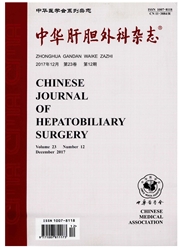

 中文摘要:
中文摘要:
目的研究S腺苷蛋氨酸(SAMe)对急性缺血/缺氧过程中肝癌细胞HepG2生物学特性的作用,并通过应用氯喹(CQ)抑制自噬探讨其可能机制。方法用实时PCR检测自噬特异性基因(Beclin1)表达的变化。吖啶橙染色后,采用荧光显微镜对自噬进行定性观察。CCK8法检测HepG2细胞生存率。Westernblot检测蛋白LC3的变化。用AnnexinV/PI流式细胞仪检测细胞凋亡的变化。结果缺血/缺氧可以促进HepG2细胞生长,细胞生存率比空白对照组增加了20%~30%。sAMe可诱导HepG2细胞自噬的表达,自噬在荧光强度和Beclin1基因水平分别比空白对照组增强约3.2倍和3.5倍。SAMe对HepG2细胞具有显著的抑制作用,这种抑制作用在缺血/缺氧环境中更加明显。经SAMe处理后,正常和缺血/缺氧环境的细胞生存率与空白对照组相比分别下降了30%和70%。与空白对照组相比,细胞经SAMe处理后,凋亡比例增加约24%。细胞经SAMe预处理,再进行缺血缺氧后,凋亡比例增加约40%。抑制自噬后,细胞生存率下降15%~30%,细胞凋亡增加7%~16%。结论在SAMe抑制HepG2细胞生长过程中,自噬对细胞有一定的保护作用。
 英文摘要:
英文摘要:
Objective To investigate the role of S-adenosylmethionine (SAMe) during ischemi- a/hypoxia in hepatocellular carcinoma and its underlying mechanism through autophagy inhibition by chloroquine (CQ). Methods Real-time PCR measured the expression of Beclin 1, and quantitative a- nalysis of autophagy was performed with fluorescent microscope on acridine orange staining. The cel- lular viability was detected by the CCK8 method, the LC3 protein was detected by Western blot, and apoptosis was detected by AnnexinV/PI flow cytometry. Results The cellular viability under ischemi- a/hypoxia increased about 20% - 30%. SAMe induced autophagy in the hepatoma cell line HepG2, and the level of autophagy in fluorescent intensity and real-time PCR of Beclin 1 increased about 3.2 and 3.5 times, respectively. SAMe significantly inhibited the proliferation of HepG2, especially in the environment of ischemia/hypoxia. The cellular viability under SAMe treatment only and SAMe-treat- ment followed by ischemia/hypoxia decreased about 30 % and 70 %, respectively, and cellular apopto- sis increased about 24o//00 and 40%, respectively, over blank control. After autophagy inhibition, the proliferation of HepG2 decreased about 15 % - 30 % and cellular apoptosis increased about 7 % - 16 %. Conclusions SAMe inhibited the proliferation of HepG2, and autophagy may be a protective factor during acute ischemic hypoxia.
 同期刊论文项目
同期刊论文项目
 同项目期刊论文
同项目期刊论文
 The Different Induction Mechanisms of Growth Arrest DNA Damage Inducible Gene 45 beta in Human Hepat
The Different Induction Mechanisms of Growth Arrest DNA Damage Inducible Gene 45 beta in Human Hepat 期刊信息
期刊信息
